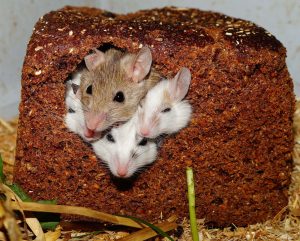 As the weather gets colder, we want to spend more time indoors…and so do rodents. Rats, mice and squirrels are in search of a warm, toasty place with food and nesting materials nearby. That’s why winter is a prime time for mouse infestations.
As the weather gets colder, we want to spend more time indoors…and so do rodents. Rats, mice and squirrels are in search of a warm, toasty place with food and nesting materials nearby. That’s why winter is a prime time for mouse infestations.
In fact, according to the National Pest Management Association (NPMA), rodents invade about 21 million homes each winter. Roughly 24 percent of homeowners will report mice or rats on their properties during this season.
While spotting a mouse in your house may not seem too ominous, mice quickly can become a big problem — chewing through electrical wire, getting into and contaminating food, and spreading disease.
The following are common questions and answers about mice infestations and how to prevent them:
 How do I know if I have mice in my home? Aside from actually seeing a mouse (alive or dead), there are many other signs to watch for that can indicate mice in your home:
How do I know if I have mice in my home? Aside from actually seeing a mouse (alive or dead), there are many other signs to watch for that can indicate mice in your home:
- Gnawed holes in stored foods, piled papers, insulation, etc.
- Skittering or scratching sounds coming from wall, ceiling, floor cavities
- Droppings (black, rice-size pellets) or tiny hairs
- Nests or nesting materials: mice build nests in dark, recessed areas of the home. Materials they use to build their nests include cotton, cardboard, paper products, and packing material
- Food scraps or wrappings left behind
I’ve only seen one mouse in the house. Is it really a big deal? If you see just one mouse in your house, you can safely assume that there are more. A female mouse can have up to 35 babies in a year, all of which might be lurking somewhere in your home.
What do mice eat? Mice will feed on almost anything but tend to prefer cereal grains and plants. They also are drawn to dried (and bagged) food, including pet food.
How long do mice live? A house mouse will rarely live more than a year in the wild. However, in a protected environment with food and water (like your home!), it can live up to three years.
I think I have mice, but I never see any. Why? Mice are nocturnal, so they are most active between dusk and dawn. While they don’t usually like bright lights, a mouse may be spotted during the day, especially if its nest has been disturbed or it is seeking food. If you see a mouse during the day, it can indicate a large infestation in a home.
 How are mice getting into my home? Mice can slip through holes and gaps as small as one-quarter inch — roughly the size of a pencil. If an opening isn’t big enough to squeeze through, they just gnaw it until it is big enough. Mice can jump 13 inches high, run along wires, cables and ropes, and they can scale rough and vertical surfaces.
How are mice getting into my home? Mice can slip through holes and gaps as small as one-quarter inch — roughly the size of a pencil. If an opening isn’t big enough to squeeze through, they just gnaw it until it is big enough. Mice can jump 13 inches high, run along wires, cables and ropes, and they can scale rough and vertical surfaces.
How do I clean up mouse droppings? Mice aren’t just unwanted tenants — they spread disease. Vacuuming up mouse droppings can actually stir up dust and spread contamination. The Centers for Disease Control and Prevention (CDC) offers detailed guidelines for cleaning up after rodents such as mice.
The NPMA provides the following tips for keeping mice out of your home:
- Seal cracks and holes on the outside of your home
- Store firewood at lease 20 feet from your home and five feet off the ground
- Rodents hide in clutter, so keep areas clear and store boxes off the floor
- Store food in rodent-proof containers
If you suspect an infestation, contact A-1 Able at 1-800-737-8189 to inspect and treat the problem.

Recent Comments